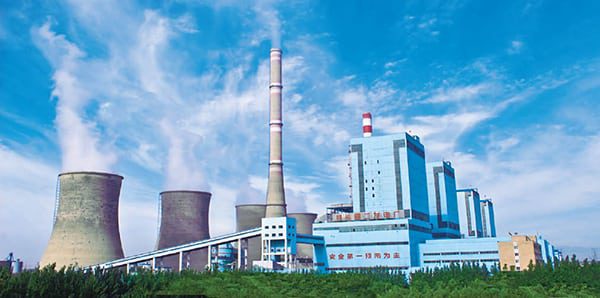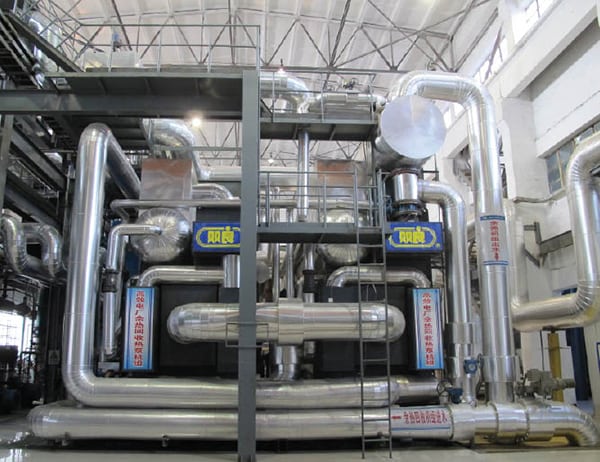Top Plant: Shentou Second Power Plant, Shuozhou City, Shanxi Province, China
Owner/operator: Shenhua Guoneng Energy Group Corp. Ltd.
A modern coal-fired power plant may operate with a thermal efficiency of 40% to 45%, which means that 55% to 60% of the fuel energy entering the plant is rejected as waste heat up the stack or to the condensing system. Economic recovery of that low-level energy has stymied plant designers for years. Shentou Second Power Plant presents an excellent solution.
The 4 x 500-MW Shentou Second Power Plant is located in Shuozhou City in the northern Shanxi Province, a region notable for its mining of coal and other minerals. Construction of the plant began in 1987, with Units 1 and 2 entering commercial operation in July 1992 and October 1993, respectively. Several years later, the plant was expanded with two additional like-sized units that entered service in 2005.
The electricity produced by the plant is sent to the Shanxi and Beijing-Tianjin-Tangshan power grids that deliver electricity to the large eastern populations centers of China. Shentou Second Power Plant also operates the grid’s 500-kV booster station, one of the largest booster stations in north China when constructed, which dramatically increased the power transmission capability of Shanxi to Beijing and Tianjin regions. Shentou Second Power Plant plays an extremely important role in the Shanxi and North China power grids.
Reducing Emissions, Increasing Efficiency
One of the primary goals of China’s 12th Five-Year Plan, issued in 2012, is the expansion of distributed energy sources, including efficient production and use of energy (see “China’s 12th Five-Year Plan Pushes Power Industry in New Directions” in the January 2012 issue). The municipal government of Shuozhou has vigorously promoted improved energy efficiency and reduced regional air emissions, particularly during the winter heating season. In this region many small, inefficient, and scattered coal-burning systems were used to produce space heating, but they also produced significant uncontrolled emissions. Also, upgrades to the existing heating system lagged the pace of new construction in the city and the many independent heating systems in the urban areas did not form an integrated network. In addition, there was little backup heating capacity, a serious concern for a region with very cold winters.
The municipal government of Shuozhou decided to close these disparate small power plants and district coal-burning heating boilers. But an alternative and reliable heat source was required if these old power and boiler plants were to be closed. The replacement heating would be sourced from Shentou Second Power Plant’s four steam units.
A cooperative agreement between Shanxi Shuangliang Renewable Energy Industry Group Co. (SSREIGC), Shentou Second Power Plant, and the municipal government of Shuozhou City was reached at the end of 2010. The agreement called for modifications to each of Shentou’s four steam turbines for extraction steam and the installation of condensing heat-recycling technology. Development work on the project was conducted by SSREIGC, specialists in waste heat recovery into electricity systems, particularly waste heat in the range of 20C to 250C using absorption chillers, waste heat boilers, and heat exchangers. Recovery of waste heat from the plant allows Shentou to meet the 12th Five-Year Plan objectives of reducing water consumption (from the cooling towers), saving energy, and reducing emissions. The agreement also required SSREIGC to update the central heating systems of Shuozhou City.
SSREIGC soon completed its feasibility report and preliminary design of the project in early 2011. Construction proceeded in two phases. The 675 million yuan (~$110.3 million) phase one started on May 15, 2011, first began supplying central heat to six million square meters of downtown area on Oct. 25, 2011, and continued to do so through the heating season that ended on Apr. 15, 2012.
After the power plant modifications and addition of the absorption chillers and other auxiliary equipment were completed, the new heat recovery systems on Units 1 and 2 were immediately placed into operation to help meet the heating season thermal load. Operation of the absorption chillers and central heating season is reported as having gone smoothly and met the required performance standards. Phase two was recognized as a key urban construction project in 2012 by the municipal government of Shuozhou and cost an additional 400 million yuan (~$65.3 million) to heat another six million square meters.
The central heating project will eventually serve about 20 million square meters of central heating area in Shuozhou City when completed in 2020. Total investment cost of the project is estimated at 1.41 billion yuan (~$230 million).
Unit Upgrades
The new central heating system is based on absorption heat pump technology to recycle the low-grade waste heat normally rejected by power plants to produce hot water for central heating. Each of Shentou Second Power Plant’s four units was originally equipped with a Czechoslovakia-made 500-MW condensing steam turbine that was modified to supply extraction steam, up to 550 metric tons per hour (tph) at 0.5 MPaG (~72 psig), to the heat recovery system as part of the project. The main steam flow rate for each of the four units is 1,650 tph. The extraction steam is the heat source that drives the operation of the lithium-bromide absorption heat pump system. The condensed extraction steam from the absorber’s generator section is returned to the unit’s condensate steam (Figure 1).
The waste heat originates with the cooling (condensing) water system, from which it is recovered before it leaves the plant for the evaporative cooling towers. The amount of water that goes to the cooling tower remains constant, but the temperature entering the tower is reduced, which reduces the tower’s heat duty, the evaporation rate, and thereby the makeup water required. Cooling water at 30C enters and leaves the evaporator section of the absorption heat pump at 26C.
The return water from the central heating system enters the absorption system at 55C, where it is heated by energy removed from the cooling water before it then enters a separate final heater, where the heating water temperature is further increased to 130C before entering the central heating system. Extraction steam is the energy source to power the absorption heat pump and the final heater. New circulating pumps and controls ensure the entire heated water system operates at constant pressure. The design supply water pressure is 1.49 MPa and the return water pressure is 0.49 MPa.
The central heating network is a closed system. Sub-networks are isolated from the central heating network by means of a plate heat exchanger located at the many secondary heat exchange stations. Individual users connect their homes and businesses to these secondary networks. This approach allows the central heating network to operate at maximum pumping efficiency even as older existing networks and new customers are added. (A flow diagram of the complete absorption chiller/central heating system is available here.)
Another qualitative efficiency measure is to examine the energy produced in relation to the energy added. If the extraction steam from the plant is 1 MW thermal, then the absorption system recovers ~0.7 MW to 0.8 MW thermal from the cooling water and the central heating system receives ~1.7 MW to 1.8 MW thermal. Balancing the improved central heating efficiency is reduced plant power output because less steam travels completely through the steam turbine. During non-heating periods, the extraction steam is secured so the full 500 MW from each steam turbine is available.
Major Implications
There are 15 provinces in northern China that require winter heating, representing 40% of China’s population and 70% of its land area. In general, a 300-MW coal-fired unit can use absorption heat pump technology to produce central heating for about 2.5 million square meters of urban area. There are approximately 6.5 billion square meters of urban construction area requiring winter heating now in north China, so the potential for improved energy conservation while reducing air emissions could have a significant impact on China’s overall energy efficiency.
According to SSREIGC, the equipment and technology supplier for this project, China’s market for absorption heat pump technology when combined with the readily available steam and condensing water supply found in the typical coal-fired power plant for urban area central heating is huge. Also, the central system approach allows municipal authorities to close smaller facilities and homes that burn coal for space heating to reduce regional emissions.
Using a holistic approach to reach energy efficiency goals on the supply side that complement conservation on the demand side—while reducing regional emissions—well qualifies the Shentou Second Power Plant as a 2013 POWER Top Plant. ■
— Dr. Robert Peltier, PE is POWER’s consulting editor.

